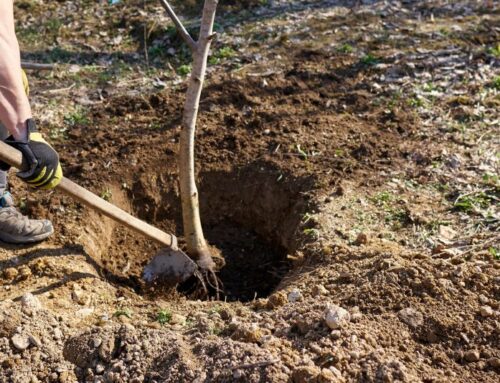Removing a tree is often necessary in landscaping projects for land development or safety improvement. But, the process involves more than just disposing of the tree because it leaves behind a noticeable void in your outdoor space. With careful planning and some creativity, you can ensure the seamless integration of your landscape after tree removals. In this comprehensive guide, we explore some effective strategies for leveling ground after the tree is removed, restoring the beauty and functionality of your outdoor area.
Understanding the Impact of Tree Removal
Tree removal has lasting effects on the surrounding environment. Beyond the obvious absence of the tree itself, factors such as disturbed soil, potential stump remnants, and altered drainage patterns can significantly impact your lawn. Recognizing these factors is crucial for planning effective post-tree removal measures.
Importance of Immediate Lawn Repair
Immediate action after tree removal is essential to prevent further complications. Whether it’s addressing uneven terrain, filling in gaps left by the tree’s roots, or re-establishing a healthy lawn, prompt repair work contributes to the overall aesthetics, safety, and usability of your outdoor space.
Step-by-Step Guide to Lawn Restoration
Restoring your lawn after tree removal requires a systematic approach. Follow these steps for successful lawn restoration:
- Assess the Damage: Begin by evaluating the extent of the damage caused by tree removal. Identify areas of soil compaction, root disturbance, and uneven terrain.
- Prepare the Soil: Thoroughly prepare the soil by removing debris and loosening compacted areas. This promotes healthy root growth and allows for better water absorption.
- Replant Grass Seeds: Fill in any bare spots with grass seeds or sod. Choose a grass variety that suits your climate and soil conditions for optimal growth.
- Water Regularly: Keep the newly planted areas consistently moist by watering regularly. Avoid overwatering, as it can lead to root rot and other issues.
- Monitor Growth: Keep an eye on the progress of your lawn restoration efforts. Monitor grass growth and address any issues promptly to ensure successful recovery.
Using SOD for Quick Lawn Recovery
SOD, or sodding, is a practical solution for achieving rapid and uniform lawn recovery after tree removal. Follow these steps for using SOD:
- Measure and Order SOD: Measure the area where you plan to lay SOD accurately and order enough SOD to cover the entire space.
- Prepare the Soil: Prepare the soil by removing debris and loosening the top layer. This creates a suitable environment for SOD installation.
- Lay the SOD: Lay the SOD pieces in a staggered pattern, ensuring tight seams and good soil contact.
- Water Immediately: Water the SOD immediately after installation to promote root establishment and prevent drying out.
- Follow Maintenance Practices: Follow recommended maintenance practices for your grass type, including regular watering and fertilization, to ensure the health of your new lawn.
The Importance of Root and Stump Removal
- Prevents Hazards: Stumps left behind can be safety hazards, posing tripping risks and attracting pests.
- Prevents Resprouting: Some tree species are very resilient, sprouting back to life even when cut back to a stump. Usage of herbicides or DIY non-chemical methods can prevent unwanted tree resurrections, but stump removal by stump grinding is the fastest way to dispose of trees permanently.
- Promotes New Growth: Removing roots and stumps creates space for new vegetation to thrive, enhancing the beauty of your landscape.
- Prevents Disease Spread: Decaying roots and stumps can harbor fungi and other pathogens, which can spread to nearby plants.
- Facilitates Landscaping: Removing roots and stumps clears the way for future landscaping projects, making installing new features or plantings easier.

Deep Root Fertilization: Why and How?
Deep root fertilization can promote the health and vitality of your remaining landscape plants after tree removal. Here’s why it’s important and how to do it:
- Provides Essential Nutrients: Deep root fertilization delivers essential nutrients directly to the root zone, promoting strong and healthy root growth.
- Improves Soil Structure: Fertilizing deep into the soil helps improve soil structure, enhancing water retention and nutrient uptake.
- Stimulates Growth: Fertilization stimulates new growth, helping your landscape plantings recover more quickly after tree removal.
- Reduces Stress: Fertilizing helps reduce stress on your plants, making them resilient to environmental factors like heat and drought.
- How to Do It: To fertilize deep roots, use a specialized fertilizer injector or hire a professional arborist. Inject the fertilizer directly into the soil around the tree’s root zone, following the recommended application rate and timing guidelines.
Creative Landscaping Ideas Post Tree Removal
With the canvas cleared by tree removal, you can redefine your landscape. Here are five creative landscaping ideas to consider:
- Install a Garden Bed: Create a garden bed in the space formerly occupied by the tree. Plant flowers, shrubs, or vegetables to add color and texture to your landscape.
- Add a Water Feature: Install a small pond or fountain to add a soothing element to your outdoor space. Water features attract wildlife and create a focal point in your yard.
- Build a Patio or Deck: Construct a patio or deck where the tree once stood. This provides a functional outdoor living space for entertaining or relaxing.
- Create a Rock Garden: Using natural stones and boulders, design a rock garden. Plant drought-tolerant succulents and cacti for a low-maintenance, visually striking landscape.
- Plant a Tree: Consider planting a new tree to replace the removed one. Choose a species well-suited to your climate and soil conditions, and select a location that allows for ample growth space.

By implementing these creative landscaping ideas, you can transform the aftermath of tree removal into an opportunity for a refreshed and vibrant outdoor environment. Whether you’re looking to enhance functionality, add visual interest, or promote biodiversity, there are endless possibilities for creating a landscape that reflects your style and enhances the beauty of your home.





